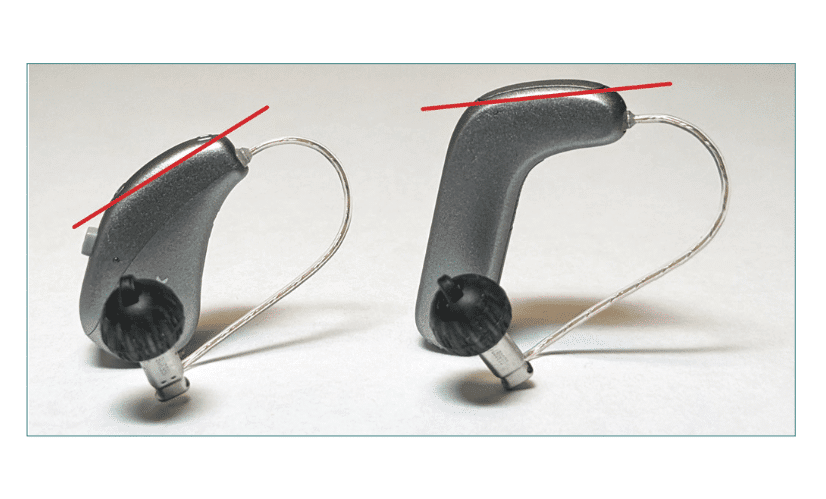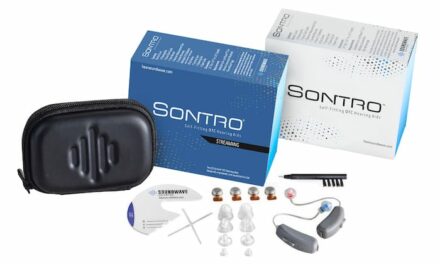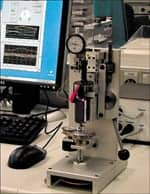While the look of a hearing aid can impact user acceptance, the effect of its microphone angle on performance is also important.
Figure 2 (at top). A side-by-side picture of the Moment mRIC (left) and the SmartRIC (right).
By Francis Kuk, PhD; Christopher Slugocki, PhD; Petri Korhonen, MSc; Heidi Peeters, MA
The two factors consistently identified as among the main reasons for hearing aid (HA) non-acceptance are unsatisfactory speech-in-noise (SIN) performance and perceived stigma associated with HA use.(1) Logic would suggest that HAs that do not look like traditional HAs and/or can further improve SIN performance may increase wearer acceptance.
Even though the looks of HAs have improved significantly with the use of receiver-in-canal (RIC) designs, many still look like HAs and could carry the usual stigma. Modernizing hearing aid design thus offers the potential to change how HA candidates feel about wearing their devices. Speaking to this, Hakvoort and Burton(2) conducted a marketing study on a modern-looking HA design by recruiting 508 non-HA wearers between 40 and 65 years of age (average = 58 years) who reported a mild-to-moderate hearing loss. In their study, participants were shown pictures of the new HA design along with more traditional RICs from several manufacturers.
The study found that the modern hearing aid design attracted more attention and was remembered longer than traditional RIC designs. Also, it was associated with a higher intention to purchase (65% vs approximately 10% for each of the other two RIC designs). The results from Hakvoort and Burton’s study would suggest that a more modern-looking HA design that looks different from other HAs could reduce stigma and increase interest in HA trials, if not acceptance also.
Even though a more attractive design may increase consumer interest in trying out HAs, it is their performance that keeps the consumers’ interest in using the product. The MarkeTrak 10(3) reported that owners of HAs are content with their performances in various listening environments while non-owners cited no noticeable improvement as the main reason for hearing aid non-acceptance. This is especially true in noisy situations. Despite the continuous improvement in signal processing algorithms that targets SIN improvement, the only proven solution is still directional microphone technology.
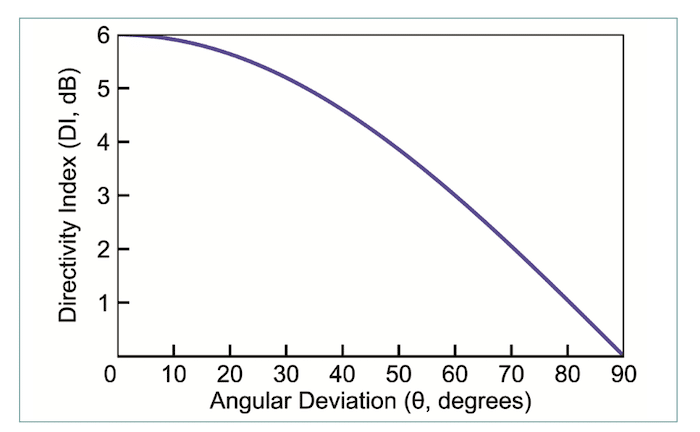
A key factor affecting the efficacy of a directional microphone is its directivity index (DI), or how much of the signal from the front is favored over signals from other directions. In a dual-microphone directional system, the DI is dependent on the angle formed between the two microphone openings relative to the horizontal plane (or microphone angle or angle for short). DI decreases (or worsens) as the microphone angle increases (Figure 1). The change in DI is small when the microphone angle is less than 20°; however, larger changes occur when the angle increases beyond 30° or so. When the angle exceeds 60°, the effective DI drops to less than half. Thus, if the microphone angle can be kept under 20°, one could preserve most of the theoretical DI (6 dB) of a dual-microphone system. Unfortunately, the microphone angles in typical RIC devices range between 30° and 40°, suggesting a theoretical maximum of only 4-5 dB in real-life use.
The need for a more stylish hearing aid design and the opportunity to ensure SIN performance of our directional microphone system prompted Widex engineers to create the SmartRIC, a new design that preserves the proven features of the Moment platform. In addition to the sleek look, the top of the SmartRIC is designed to be flat so that the microphone angle can be less than 20° relative to the horizontal plane. Figure 2 at the top shows a comparison between the SmartRIC and the Moment mRIC designs.
In this study, we compared the behavioral signal-to-noise ratio (SNR) performance offered by the SmartRIC and that of the Moment mRIC in the directional mode when both were fully matched in frequency characteristics, with and without the use of noise reduction (NR).
Further reading: Efficacy of Directional Microphones in Open Fittings Under Realistic Signal-to-Noise Ratios Using Widex MOMENT Hearing Aids
Hearing Aid Study Method
A total of 15 subjects (8 females) with a moderate-to-severe degree of sensorineural hearing loss participated in the study. Subjects ranged in age from 53 to 88 years (average = 74 years). All but two subjects wore HAs for an average of 6 years. All subjects were satisfied (>3 out of 5) with their current hearing aids. All subjects passed cognitive screening on the Montreal Cognitive Assessment (MoCA, average = 28). Subjects were tested with the SmartRIC and the Moment mRIC using the same properly sized instant double eartips with an m-receiver.
The audiometric thresholds of the subjects were used to program the HAs. Afterward, the simulated real-ear output from both hearing aids was measured and matched (within 2 dB) across frequencies using the Audioscan Verifit2. Both HAs were set to a fixed directional mode with the digital NR algorithm evaluated in the “on” and “off” conditions.
Subjects were seated in the middle of the sound booth one meter from the front and sides/ back loudspeakers. Subjects were instructed to sit comfortably and have their heads in a typical, comfortable position. A chin rest was placed underneath the subjects’ chins. Subjects’ foreheads rested against a bar to prevent any changes in head position (and angles) during testing. Afterward, the test HAs were placed onto subjects’ ears using the receiver-wires with the proper lengths. Because of the new design, a shorter receiver-wire was needed in 8 of the 15 subjects in the SmartRIC design over the Moment mRIC design. Receiver wires with the proper lengths were necessary so the different HAs sat properly over the pinna with the smallest angle between the two microphone openings.
The angle formed by the two microphone openings was first estimated with a smartphone App (inclinometer). A picture of the hearing aid in-situ was taken and later processed with a graphics editor program (Inkscape, version 1.3.2) to accurately determine the angle formed between the two microphone openings. The correlation between the angles measured with both tools was r = 0.90, suggesting that both methods yielded a good estimate of the microphone angles. We will report on the microphone angles measured using the graphics editor in this article.
The SNR improvement provided by the directional microphone and NR algorithm on the SmartRIC over the Moment mRIC was evaluated using the adaptive Hearing-In-Noise Test (HINT). A fixed, continuous 2-talker babble noise was presented at an overall level of 70 dB SPL from 90°, 180°, and 270°. The noise was presented 30 seconds prior to the onset of the speech stimulus. The level of the speech stimulus was initially set to 75 dB SPL and was adaptively changed based on the subjects’ responses. Both HAs were evaluated in the fixed directional mode under NR “on” and “off” conditions in a counterbalanced order. A different HINT list was used for each HA condition. Each condition was tested twice.
Results: Microphone Angles and SNR
Microphone Angles
The angles measured between the two microphone openings on the Moment mRIC are displayed along with those on the SmartRIC in Figure 3. The angles ranged from 30° to 50° with a mean of 37° on the Moment mRIC and 6° to 21° with a mean of 12° on the SmartRIC. This supports the expectation that the microphone angles on the SmartRIC are significantly smaller than those on the Moment mRIC.
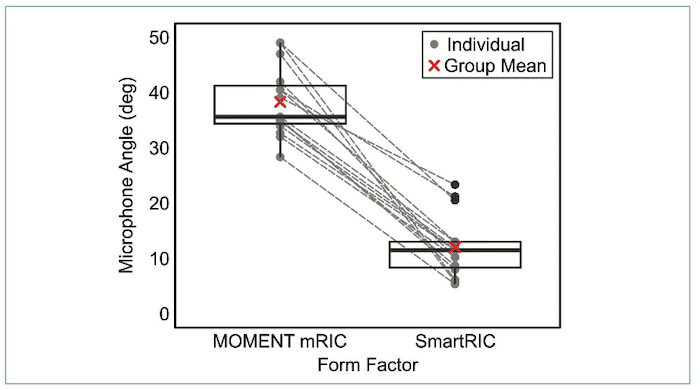
Signal-to-Noise Ratio (SNR) Improvement on the HINT
Figure 4 plots the speech reception threshold at 50% performance (SRT50) measured with the SmartRIC against the SRT50 measured with the Moment mRIC, for both NR on (filled) and NR off (unfilled). A parity line was also included for ease of visualization. The majority of the data points were below the parity line, suggesting that the SRT50 measured with the Moment mRIC was higher (or poorer) than those measured with the SmartRIC. On the other hand, NR did not make a difference.

A linear mixed effect model was used to examine the scores (measured as SNR for SRT50) measured between two form factors (SmartRIC and Moment mRIC), noise reduction conditions (On and Off) and trials. The results suggest a significant effect of form factor (χ2 = 25.06, p < 0.001) but no significant effects of noise reduction and trials or their interactions. Figure 5 shows the SRT50 for each form factor. On average, the SRT50 measured with SmartRIC was about 1.25 dB smaller (or better) than that of the Moment mRIC.
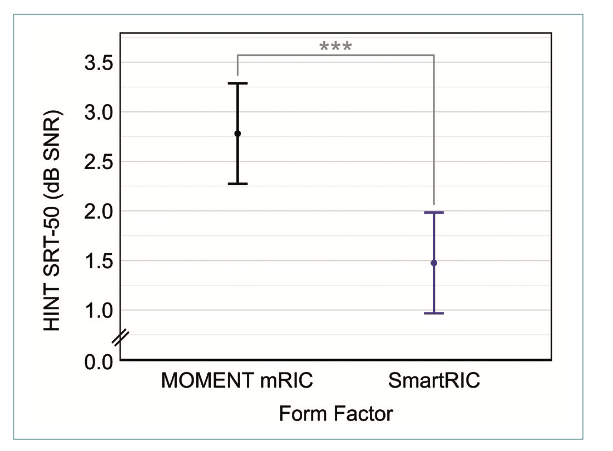
Discussion
The current study showed that the design used in the SmartRIC hearing aid changed the microphone angle from an average of 37° (as in the mRIC) to an average of 12°, which significantly improved the SNR provided by the mRIC design used in the Moment mRIC hearing aid by 1.25 dB (from an average of 2.75 dB to 1.5 dB).
One is reminded that the performance of the Moment mRIC is already very good. The majority of the subjects in this study had a moderate-to-severe hearing loss; yet all of them required less than 6 dB to achieve their SRT50s (with an average of 2.75 dB). The additional 1.25 dB improvement seen in the SmartRIC (to an average of 1.5 dB) could further increase HA acceptance in noisy situations for SmartRIC wearers.
Assuming that the performance-intensity function for sentence materials has a slope of 10%/dB intelligibility, the 1.25 dB improvement seen in the SmartRIC over the Moment mRIC suggests that the SmartRIC would yield about 12.5% improvement in speech understanding in noise when the wearer’s head is in a neutral position. Wearers of the SmartRIC can expect better speech understanding than wearers of the Moment mRIC when the HAs are worn in the normal manner.
More importantly, when the wearer raises or lowers his/her head from the neutral position by the same amount, the effective DI changes from the theoretical maximum would be less in the SmartRIC than in the Moment mRIC. For example, if the wearer raises his/her head by 10°, the effective microphone angle with the SmartRIC will be 22° and that of the Moment mRIC 47°. Figure 1 suggests that the DI would change from 5.9 dB when the SmartRIC is at 12° to 5.6 dB when it is at 22°, or a drop of 0.3 dB in DI. On the other hand, the Moment mRIC would drop from a DI of 4.8 dB when the microphone angle is 37° to 4.1 dB when the microphone angle is 47°, or a drop of 0.7 dB in DI.
In other words, the impact of any vertical head movement (as in raising or lowering the head) is far smaller when the microphone angles are smaller (as in the SmartRIC) than when they are larger (as in the Moment mRIC). This suggests that the modern SmartRIC design not only improves SIN performance, but also ensures the consistency of SIN performance from inadvertent head movements.
Because microphone angles have important consequences on a HA’s performance, hearing care professionals should consider selecting HAs with a small microphone angle. In addition, clinicians may consider measuring the in-situ microphone angles routinely after their HA fittings to ensure a comfortable fit with the smallest microphone angle.
Francis Kuk, PhD, is the director, Christopher Slugocki, PhD, is a research scientist, Petri Korhonen, MSc, is a senior research scientist, and Heidi Peeters, MA, is a research audiologist at the WS Audiology Office of Research in Clinical Amplification (ORCA) in Lisle, Ill.
Original citation for this article: Kuk F.; Slugocki C.; Korhonen P.; Peeters H. Forms Influence Functions: Microphone Angle and Speech-in-Noise Performance. Hearing Review. 2024;31(3): 14-19.
References
- Powers T, Rogin C. MarkeTrak 10 (MT10): hearing aids in an era of disruption and DTC/OTC devices. Hearing Review. 26(8): 12-20.
- Hakvoort C, Burton P. 2018. Increasing Style, Reducing Stigma: The Styletto Solution. Signia white paper. https://www.signia-library.com/scientific_marketing/styletto_solution/
- Picou EM. MarkeTrak 10 (MT10) survey results demonstrate high satisfaction with and benefits from hearing aids. Semin Hear. 41(1): 21–36.

